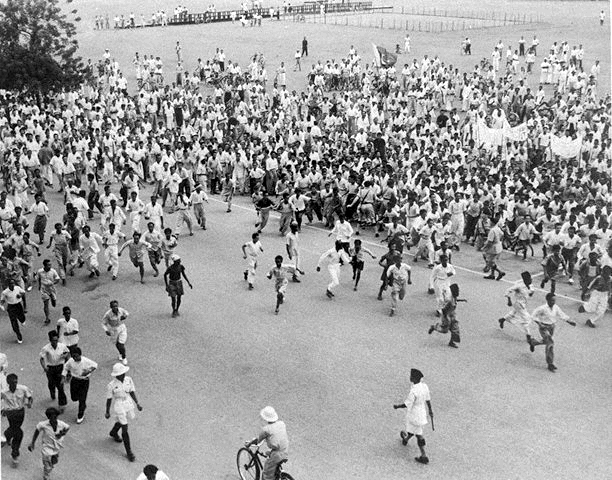- 1964 Race Riots
thumb|right|350px|The_start_of_the_July_riot_on_the_Prophet_Muhammad 's birthday that would later injure hundreds and kill 23 people.] The 1964 Race Riots were a series ofriot s that took place inSingapore during two separate periods in July and September between Chinese and Malay groups. The first incident occurred on21 July during a Malay procession that markedMuhammad 's birthday. In total, the violence killed 36 people and injured another 556. About 3,000 people were arrested. The riots are also known as the Prophet Muhammad Birthday Riots, 1964 Racial Riots, and 1964 Sino-Malay Riots. At that time, Singapore was a state in theFederation of Malaysia .July riots
On 21 July, 1964, about 25,000 Malays gathered at
Padang, Singapore to celebrate the ProphetMuhammad 's birthday. After the speeches, the procession went on to Geylang. Along the way, a group that was dispersed was asked to rejoin the procession by a policeman. Instead of obeying the orders, the group attacked the policeman. This incident led to a race riot after the group of Malays attacked Chinese passers-by and spectators. The riots were reported to have started at about 5:00 p.m. betweenKallang andGeylang Serai . Acurfew was declared at 9.30 p.m. to restore order, but in the first day of riot, four people were killed and 178 injured. [Lai Ah Eng (2004). "Beyond rituals and riots : ethnic pluralism and social cohesion in Singapore", Eastern Universities Press, ISBN 981-210-272-8]After the curfew was lifted at 6 a.m. the next morning, the conflict grew even more tense, and another curfew was imposed - only lifted for short periods for people to buy food. The curfew was completely lifted on
2 August , 11 days after the start of the riots. After the riots, goodwill committees were set up made up of community leaders from the various racial groups. The main job of these leaders was to help restore peace and harmony between the Malays and the Chinese by addressing the concerns of the residents. About 23 people lost their lives and 450 people were injured during the July riots. There was significant damage to property and vehicles.About 3,000 people were arrested, including 600 secret society members and 256 people arrested for possession of dangerous weapons. The rest were arrested for violating the curfew.Causes
Different kinds of reasons have been cited for causing the riots. Malaysia Deputy Prime Minister
Tun Abdul Razak blamed Indonesian and Communist provocateurs.On the other hand, Singapore Prime Minister
Lee Kuan Yew and several other foreign observers attributed the riots as the result of agitation bySyed Jaafar Albar and other elements of the ultra-nationalist faction inUMNO . According to the Australian Deputy High Commissioner,W.B. Pritchett :"...there can be no doubt that UMNO was solely responsible for the riots. Its members ran the communal campaign or allowed it to happen." [Lau, Albert (2000). " A Moment of Anguish: Singapore in Malaysia and the Politics of Disengagement", Times Academic Press, ISBN 981-210-134-9]
The riots occurred during the period when the
PAP-UMNO relations were severely strained after thePeople's Action Party challenged the UMNO in the March 1964 Malaysia federal election with the campaign slogan of "Malaysian Malaysia ".In addition, the involvement of Chinese secret societies in the riots also increased the level of violence.
eptember riots
A second race riot occurred just a month after the first on 3 September. This time, a Malay
trishaw -rider was found murdered at Geylang Serai and his attackers were believed to be a group of Chinese. The race riot ensued in the neighbourhoods ofGeylang ,Joo Chiat andSiglap , and another curfew was imposed. In this incident, 13 people lost their lives and 106 people were injured. Under the presence of troops and the imposing of curfews, these tensions eventually eased after a few days. 480 people were arrested.Both Malaysia and Singapore have attributed the September riots to Indonesian provocateurs. It was the
Konfrontasi period and 30 Indonesian paratroopers had landed inLabis , Johor on 2 September.Aftermath
Leaders in Malaysia and Singapore were surprised by the rapid escalation of racial violence and both sides made frequent appeals for calm. The riots exposed serious racial tension and the fear of further violence contributed to Singapore's secession from the Federation of Malaysia in 1965, when both sides were unable to resolve their disputes.
During the riots, large number of arrests was made under the Internal Security Act (ISA), for those involved in subversion and rioters who were members of secret societies. This helped to contain the violence, especially during the September riots. ISA remains in force in both countries and is used to counter potential threats of communism or racial and religious violence.
References
ee also
*
1969 Race Riots of Singapore
*May 13 Incident
*Maria Hertogh riots
*Anti-Malay racism External links
* [http://library.thinkquest.org/04oct/00301/project%20thinkquest/pages/p8.html Racial Innovation - A Case Study]
* [http://www.csmonitor.com/2002/0205/p07s01-woap.html In placid Singapore, civil disobedience simmers]
Wikimedia Foundation. 2010.

